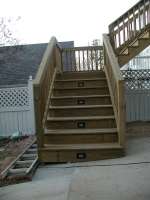DECK, SCREEN PORCH BUILDER
A ergonomic, safe and beautiful exterior living space, even if small, is a must for any house, especially in Chapel Hill, Durham and Hillsborough area's climate with it's abundance of great weather. There are a few things to be considered when planning to add, expand or modify a deck.

Structure
All decks are typically constructed of treated lumber – both the good and the bad ones. The difference is in the way of assembly and details, which are of little interest to anyone until a spectacular failure. YouTube has quite a few to see. Needless to say, this kind of disaster is not only dangerous and unwelcome, but also expensive. The two most common areas of failure are the back of the deck, where it's attached to the house, and the railings. Production-built “one-a-day” decks are the ones most likely to have the structural flaws, as well as deficiencies in the barriers, meant to prevent water from ruining the house. Of course, such decks are often the cheapest to build as well, with all the savings achieved by not buying essential hardware and skipping important construction steps. So there's that.
Besides missing hardware and nail-on railing posts, other potential trouble areas to watch are under-sized or over-spanned joists and girders, inadequate or absent footers and over-notched railing newels.
Decking
Other than extraordinary hardwoods from faraway exotic lands, two types of decking used most in Chapel Hill, Durham and Hillsborough area are pressure treated pine and composites. Here is a little bit about both.
Treated wood decking: one important thing to know about this material is that there is are four (that's 4!) different grades of it. So, when you compare two deck quotes, both specifying treated decking, there is one important question to be asked: “WHAT TREATED DECKING???” The difference between #3 and premium, so called “Clear and better” is in the number of knots and other flaws in the wood, which results in major service life disparity. Knots, splits and checks take in water, which through cycles of freezing and evaporation relatively quickly erodes the boards, making them very uncomfortable to walk on and, ultimately, causes failures. Often, premium grades of treated decking, such as Severe Weather, for example, are additionally treated with water repellents for increased life span.
Composite decking: there is a staggering number of different brands of composite decking brands, each with proprietary formulations. Typically they include resin, volume fill, such as sawdust, recycled paper, etc. and treatments to protect the boards from mold, mildew, degradation by UV rays in sunlight, as well as flame retardants. There are few PVC decking brands out there as well. Barred occasional reports of some issues, these products are great – they look and perform fantastic, without any need for painting or sealing. Many of them can be installed with hidden fasteners – without any visible screws or nails! If you ask me, I would say that the future belongs to composite decking. I would love to see it become more affordable sometime soon, though. Currently, budget brand composite deck boards cost about double the price of premium treated decking.
Decks built by Trades of the Triangle don't only look great, but also last, because we pay particular attention to structural integrity and protecting the areas where the deck connects to your home to avoid any possibility of water penetration in those vulnerable spots.







